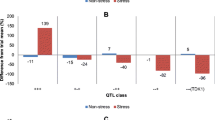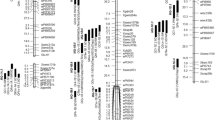Abstract
In most maize-growing areas yield reductions due to drought have been observed. Drought at flowering time is, in some cases, the most damaging. In the experiment reported here, trials with F3 families, derived from a segregating F2 population, were conducted in the field under well-watered conditions (WW) and two other water-stress regimes affecting flowering (intermediate stress, IS, and severe stress, SS). Several yield components were measured on equal numbers of plants per family: grain yield (GY), ear number (ENO), kernel number (KNO), and 100-kernel weight (HKWT). Correlation analysis of these traits showed that they were not independent of each other. Drought resulted in a 60% decrease of GY under SS conditions. By comparing yield under WW and SS conditions, the families that performed best under WW conditions were found to be proportionately more affected by stress, and the yield reductions due to SS conditions were inversely proportional to the performance under drought. Moreover, no positive correlation was observed between a drought-tolerance index (DTI) and yield under WW conditions. The correlation between GY under WW and SS conditions was 0.31. Therefore, in this experiment, selection for yield improvement under WW conditions only, would not be very effective for yield improvement under drought. Quantitative trait loci (QTLs) were identified for GY, ENO and KNO using composite interval mapping (CIM). No major QTLs, expressing more then 13% of the phenotypic variance, were detected for any of these traits, and there were inconsistencies in their genomic positions across water regimes. The use of CIM allowed the evaluation of QTL-by-environment interactions (Q×E) and could thus identify “stable” QTLs CIMMYT, Apartado Postal 6-641, 06600 Mexico D.F., Mexico across drought environments. Two such QTLs for GY, on chromosomes 1 and 10, coincided with two stable QTLs for KNO. Moreover, four genomic regions were identified for the expression of both GY and the anthesis-silking interval (ASI). In three of these, the allelic contributions were for short ASI and GY increase, while for that on chromosome 10 the allelic contribution for short ASI corresponded to a yield reduction. From these results, we hypothesize that to improve yield under drought, marker-assisted selection (MAS) using only the QTLs involved in the expression of yield components appears not to be the best strategy, and neither does MAS using only QTLs involved in the expression of ASI. We would therefore favour a MAS strategy that takes into account a combination of the “best QTLs” for different traits. These QTLs should be stable across target environments, represent the largest percentage possible of the phenotypic variance, and, though not involved directly in the expression of yield, should be involved in the expression of traits significantly correlated with yield, such as ASI.
Similar content being viewed by others
Author information
Authors and Affiliations
Additional information
Received: 8 July 1996 / Accepted: 6 December 1996
Rights and permissions
About this article
Cite this article
Ribaut, JM., Jiang, C., Gonzalez-de-Leon, D. et al. Identification of quantitative trait loci under drought conditions in tropical maize. 2. Yield components and marker-assisted selection strategies. Theor Appl Genet 94, 887–896 (1997). https://doi.org/10.1007/s001220050492
Issue Date:
DOI: https://doi.org/10.1007/s001220050492




